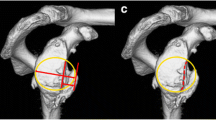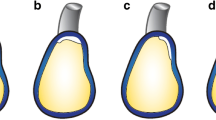Abstract
The inherently unstable anatomy of glenohumeral (GH) joint predisposes it to shoulder dislocation. Shoulder dislocation can occur either due to acute trauma or due to chronic microtraumas in the setting of underlying morphological abnormality. A plain radiograph is the initial imaging modality for diagnosis and management of shoulder dislocation and its associated osseous abnormalities such as Hill-Sachs deformity or osseous Bankart lesion. However, advanced imaging techniques such as multidetector CT (MDCT) with three-dimensional (3D) volume rendering and MRI can be helpful in further characterization of osseous abnormalities and detection of associated soft tissue injuries, respectively. These additional findings may be useful for optimal surgical repair for GH joint stabilization. In this pictorial essay, we present the clinically relevant osseous and soft tissue pathologies in various types of shoulder dislocation, with emphasis on pathologies that can be demonstrated using advanced imaging examinations. Discussed pathologies include glenoid fractures, labral tears, Bankart lesion, Hill-Sachs defect, Perthes lesion, anterior labral posterior sleeve avulsion (ALPSA), glenolabral articular disruption (GLAD), humeral avulsion of the glenohumeral ligament (HAGL), Kim lesion, and other associated soft tissue and nerve injuries.














Similar content being viewed by others
References
Murray IR, Goudie EB, Petrigliano FA, Robinson CM (2013) Functional anatomy and biomechanics of shoulder stability in the athlete. Clin Sports Med 32(4):607–624. doi:10.1016/j.csm.2013.07.001
Pavic R, Margetic P, Bensic M, Brnadic RL (2013) Diagnostic value of US, MR and MR arthrography in shoulder instability. Injury 44(Suppl 3):S26–S32. doi:10.1016/S0020-1383(13)70194-3
Geusens E, Pans S, Verhulst D, Brys P (2006) The modified axillary view of the shoulder, a painless alternative. Emerg Radiol 12(5):227–230. doi:10.1007/s10140-006-0484-x
Acid S, Le Corroller T, Aswad R, Pauly V, Champsaur P (2012) Preoperative imaging of anterior shoulder instability: diagnostic effectiveness of MDCT arthrography and comparison with MR arthrography and arthroscopy. AJR Am J Roentgenol 198(3):661–667. doi:10.2214/AJR.11.7251
Fritz J, Fishman EK, Fayad LM (2014) MDCT arthrography of the shoulder. Semin Musculoskelet Radiol 18(4):343–351. doi:10.1055/s-0034-1384824
Fritz J, Fishman EK, Small KM, Winalski CS, Horger MS, Corl F, McFarland E, Carrino JA, Fayad LM (2012) MDCT arthrography of the shoulder with datasets of isotropic resolution: indications, technique, and applications. AJR Am J Roentgenol 198(3):635–646. doi:10.2214/AJR.11.7078
Magee T (2009) 3-T MRI of the shoulder: is MR arthrography necessary? AJR Am J Roentgenol 192(1):86–92. doi:10.2214/AJR.08.109710.2214/ajr.192.5_supplement.0a86
Herold T, Bachthaler M, Hamer OW, Hente R, Feuerbach S, Fellner C, Strotzer M, Lenhart M, Paetzel C (2006) Indirect MR arthrography of the shoulder: use of abduction and external rotation to detect full- and partial-thickness tears of the supraspinatus tendon. Radiology 240(1):152–160. doi:10.1148/radiol.2393050453
Jung JY, Yoon YC, Yi SK, Yoo J, Choe BK (2009) Comparison study of indirect MR arthrography and direct MR arthrography of the shoulder. Skelet Radiol 38(7):659–667. doi:10.1007/s00256-009-0660-7
Geijer M, El-Khoury GY (2006) MDCT in the evaluation of skeletal trauma: principles, protocols, and clinical applications. Emerg Radiol 13(1):7–18. doi:10.1007/s10140-006-0509-5
Haapamaki VV, Kiuru MJ, Koskinen SK (2004) Multidetector CT in shoulder fractures. Emerg Radiol 11(2):89–94. doi:10.1007/s10140-004-0376-x
Kung JW, Wu JS, Shetty SK, Khasgiwala VC, Appleton P, Hochman MG (2014) Spectrum and detection of musculoskeletal findings on trauma-related CT torso examinations. Emerg Radiol 21(4):359–365. doi:10.1007/s10140-014-1201-9
Ozaki R, Nakagawa S, Mizuno N, Mae T, Yoneda M (2014) Hill-Sachs lesions in shoulders with traumatic anterior instability: evaluation using computed tomography with 3-dimensional reconstruction. The American journal of sports medicine 42(11):2597–2605. doi:10.1177/0363546514549543
Chuang TY, Adams CR, Burkhart SS (2008) Use of preoperative three-dimensional computed tomography to quantify glenoid bone loss in shoulder instability. Arthroscopy: the journal of arthroscopic & related surgery: official publication of the Arthroscopy Association of North America and the International Arthroscopy Association 24(4):376–382. doi:10.1016/j.arthro.2007.10.008
Nofsinger C, Browning B, Burkhart SS, Pedowitz RA (2011) Objective preoperative measurement of anterior glenoid bone loss: a pilot study of a computer-based method using unilateral 3-dimensional computed tomography. Arthroscopy: the journal of arthroscopic & related surgery: official publication of the Arthroscopy Association of North America and the International Arthroscopy Association 27(3):322–329. doi:10.1016/j.arthro.2010.09.007
Oh JH, Kim JY, Choi JA, Kim WS (2010) Effectiveness of multidetector computed tomography arthrography for the diagnosis of shoulder pathology: comparison with magnetic resonance imaging with arthroscopic correlation. Journal of shoulder and elbow surgery / American Shoulder and Elbow Surgeons [et al] 19(1):14–20. doi:10.1016/j.jse.2009.04.012
Di Giacomo G, Itoi E, Burkhart SS (2014) Evolving concept of bipolar bone loss and the Hill-Sachs lesion: from “engaging/non-engaging” lesion to “on-track/off-track” lesion. Arthroscopy: the journal of arthroscopic & related surgery: official publication of the Arthroscopy Association of North America and the International Arthroscopy Association 30(1):90–98. doi:10.1016/j.arthro.2013.10.004
Gyftopoulos S, Wang A, Babb J (2015) Hill-Sachs lesion location: does it play a role in engagement? Skelet Radiol 44(8):1129–1134. doi:10.1007/s00256-015-2134-4
Wischer TK, Bredella MA, Genant HK, Stoller DW, Bost FW, Tirman PF (2002) Perthes lesion (a variant of the Bankart lesion): MR imaging and MR arthrographic findings with surgical correlation. AJR Am J Roentgenol 178(1):233–237. doi:10.2214/ajr.178.1.1780233
Magee T (2015) Usefulness of unenhanced MRI and MR arthrography of the shoulder in detection of unstable labral tears. AJR Am J Roentgenol 205(5):1056–1060. doi:10.2214/AJR.14.14262
Waldt S, Burkart A, Imhoff AB, Bruegel M, Rummeny EJ, Woertler K (2005) Anterior shoulder instability: accuracy of MR arthrography in the classification of anteroinferior labroligamentous injuries. Radiology 237(2):578–583. doi:10.1148/radiol.2372041429
Antonio GE, Griffith JF, Yu AB, Yung PS, Chan KM, Ahuja AT (2007) First-time shoulder dislocation: high prevalence of labral injury and age-related differences revealed by MR arthrography. Journal of magnetic resonance imaging: JMRI 26(4):983–991. doi:10.1002/jmri.21092
Magee T (2014) Prevalence of HAGL lesions and associated abnormalities on shoulder MR examination. Skelet Radiol 43(3):307–313. doi:10.1007/s00256-013-1778-1
Zhu W, Lu W, Zhang L, Han Y, Ou Y, Peng L, Liu H, Wang D, Zeng Y (2014) Arthroscopic findings in the recurrent anterior instability of the shoulder. European journal of orthopaedic surgery & traumatology: orthopedie traumatologie 24(5):699–705. doi:10.1007/s00590-013-1259-1
Kosiyatrakul A, Jitprapaikulsarn S, Durand S, Oberlin C (2009) Recovery of brachial plexus injury after shoulder dislocation. Injury 40(12):1327–1329. doi:10.1016/j.injury.2009.05.015
Chalian M, Soldatos T, Faridian-Aragh N, Andreisek G, McFarland EG, Carrino JA, Chhabra A (2011) MR evaluation of synovial injury in shoulder trauma. Emerg Radiol 18(5):395–402. doi:10.1007/s10140-011-0973-4
Saupe N, White LM, Bleakney R, Schweitzer ME, Recht MP, Jost B, Zanetti M (2008) Acute traumatic posterior shoulder dislocation: MR findings. Radiology 248(1):185–193. doi:10.1148/radiol.2481071003
Yu JS, Ashman CJ, Jones G (2002) The POLPSA lesion: MR imaging findings with arthroscopic correlation in patients with posterior instability. Skelet Radiol 31(7):396–399. doi:10.1007/s00256-002-0513-0
Kim SH, Ha KI, Yoo JC, Noh KC (2004) Kim’s lesion: an incomplete and concealed avulsion of the posteroinferior labrum in posterior or multidirectional posteroinferior instability of the shoulder. Arthroscopy: the journal of arthroscopic & related surgery: official publication of the Arthroscopy Association of North America and the International Arthroscopy Association 20(7):712–720. doi:10.1016/j.arthro.2004.06.012
Author information
Authors and Affiliations
Corresponding author
Ethics declarations
Conflict of interest
The authors declare that they have no conflict of interest.
Rights and permissions
About this article
Cite this article
Demehri, S., Hafezi-Nejad, N. & Fishman, E.K. Advanced imaging of glenohumeral instability: the role of MRI and MDCT in providing what clinicians need to know. Emerg Radiol 24, 95–103 (2017). https://doi.org/10.1007/s10140-016-1429-7
Received:
Accepted:
Published:
Issue Date:
DOI: https://doi.org/10.1007/s10140-016-1429-7




